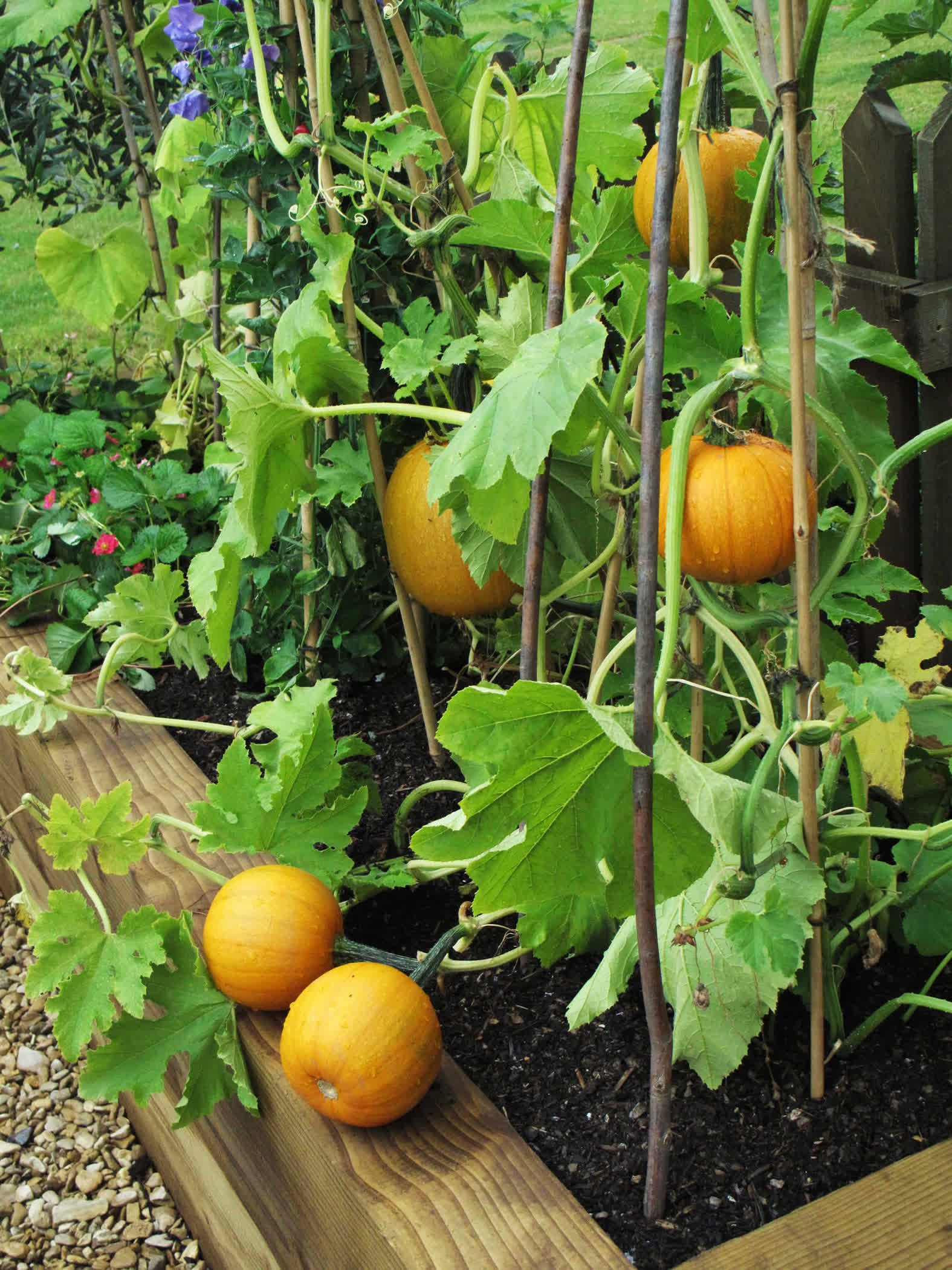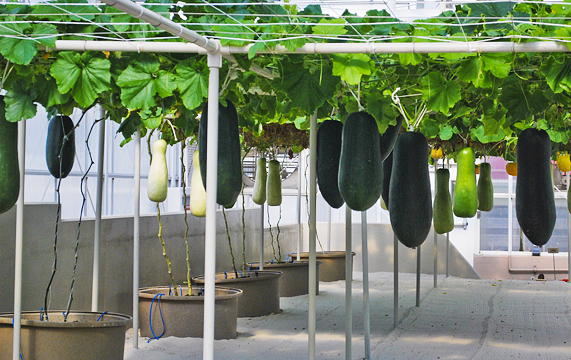|
|
Squash by growing type: bush, vining, semibush, etc.
|
|
The Long Island Cheese pumpkin was widely used as livestock feed.
Pumpkins can be fed to dogs and cats as a supplement for managing constipation or hairballs. The fiber provides the bulk matter that aids in proper digestion.
Raw pumpkin can be fed to laying hens to increase egg production in the colder months.
Pumpkin phytochemicals and nutrients have positive biological effects.
"On Kentucky Field Pumpkin: Once the industry standard for canning pumpkin. Very prolific. One of the best canning pumpkins still around. Very rare and getting harder to find. Good keeper and perfect for feeding to animals. If you have never fed pumpkins to your chickens you are missing out on some of the best, yummy orange egg yolks you have ever tasted.
" -sustainable seed
|

Growing Tips:
Sow 5 seeds per hill, 4 feet apart. Thin to best 2-3 plants. Squash seeds dislike cold soil. It's better to wait until the soil is warm to plant the seeds.
Also, squash and melons don't like to have their roots disturbed, so when thinning out seedlings in hills, cut the stems of those you want to remove, rather than pulling them out.
It also helps to place boards or old roof tiles under the fruits, to keep them from touching the ground and rotting.
Once the first fruits appear, you can pinch back the vine tips, to limit vine growth and to put the plant’s energy into maturing the existing pumpkins. However, this may limit production of more fruits.
It’s Hard to Overfertilize Pumpkins.
Several landraces are grown open-pollinated. Results are many unique squash with a blend of characteristics from what we consider species(maxima, moschata, etc): stem and peduncle shape, fruit color size and shapes etc. The farmer then chooses which ones have the characteristic their looking for and replants the seed from those squash.
Heirlooms appear to be the result of this selective breeding practice over the course of decades or centuries.
|
6 tonnes (6000 lbs) of food in one picture
Giant Pumpkins
1000 lbs of giant pumpkin fruit is 2/3 water, 1/3 flesh, making 300 lbs of food. That's a lot of food that can be grown by one plant and fits neatly on a pallet. Compare that to 1000 lbs of other crops, like peas. The water from the fruit isn't a waste either, it can be drunk as delicious Pumpkin Juice or reduced into Pumpkin Syrup.
People don't even know pumpkin is not just a food, it's dessert. The juice can be reduced to make thick, caramel-like pumpkin syrup, and the flesh can be cooked and baked into pies and puddings with a bit of egg, cream and pumpkin spice mixed in. No sugar,no crust required. Just pumpkin. This is one "dessert" you can't eat too much of.
2,000 lb Pumpkin. World's heaviest.
|
|
I am growing pumpkin on my bedrooms widow.
I planted it March, I think it was somewhere between 10th and 20th. It grows in 0,5 x 0,3 x 0,3 box filled with ordinary mineral rich houseplant soil. I water it about 3 times a week (once a week with fertilizer).
Now the plant is quite big (about 3 m in length), and has its first male flowers. - May 15, 2008
Pumpkins have very long roots and if grows in a same pot with other plant, then re-potting will damage the roots. don't re -pot it unles you don't want to re-pot it together with the other plant.
Vines- highly invasive grabbing everything near them.
To anyone attempting this, you may consider more pots of soil to be available wherever you get a female flower. The vines like to sprout roots at each fruit. If you start to get a baby pumpkin, bury the vine at the closest node. It will make new roots and provide more nutrients for the fruit itself.
It doesn't matter what type you try in the house, they will all be about the same size. Atlantic giants won't truly be one of those giant pumpkins. You have to have VERY deep soil for those to be that big and lots of other special conditions.
I love vines in the house but never thought about trying a frappin pumpkin. What's next sweet potatoes?
Indoor vs Outdoor start
PumpkinNook | Growing
|
|
Interview with Heirloom Squash farmer on pesticides.
|
|
|
|
|
Crushing the eggs as soon as you see them is recommended as the best preventative measure. Here's a note on the Squash Vine Borer and how to find the eggs:
Check your zucchini plants for SVB eggs. The moth lays them one at a time along the main stem or the stems on the leaves. I have also found them on immature flower buds.
They are a hard, light brown/dark tan speck, a little bigger than a grain of sand, or about half the diameter of a pencil lead. If you find any, gently scrape them off. You can usually get them off with your finger, but I sometimes use a pointed stick. They hatch about a week after the moth lays them. You might find a dozen or more, depending on how long she was there of if any of her friends had been by earlier.
Here’s a close-up I found online. They are a little smaller than a sesame seed. - Jamie Outlaw
|
|
Pollinating Basics: video
"Fruit begins to form within one day of blooming if the flower becomes pollinated. Summer squash fruits are usually ready to harvest within three to five days of flowering, or when the fruits are about 6 inches long." - article
|
Pumpkin and Winter Squash Seed Saving
- Cut your squash in half
- Scoop out all insides, including pulp and seeds into a bowl with some water
- Pick out the seeds and put them in a strainer
- Rinse seeds well with cool water
- Pat them dry
- Lay seeds down evenly on a tray
- Keep out of sunlight and near a cool or drafty place for 2 weeks, flipping them over after the first week
- Place seeds in sealed bag labelled with variety name and date
- Store seeds in freezer or cool place for as many years as you like
- When seeds are removed from freezer they will begin to germinate
Don't discard your pulp, it is the most nutrient dense and tastiest part of the pumpkin. Save it for processing into Pumpkin Juice Syrup or for a Pumpkin Pie Royale.
|

THE HARVEST AND STORAGE OF WINTER SQUASH
If handled correctly, they will keep for a long time. For biggest and densest fruit, leave the squash as long as possible on the vine, even after the leaves start to die down, unless there is danger of frost.
Harvest by cutting the vine either side of the stem, not cutting the stem itself. Bring inside and store in the warm for 10 days for them to cure. Ideally this is 80F / 25C, but we just keep ours in the kitchen where is is reasonably warm.
Curing like this makes lets the skin dry out and lets minor damage heal. It really makes them much longer-keeping and they can then be stored at a cool temperature (experiments prove that 55F / 12C gives the longest keeping) .
We use a spare (unheated) bedroom which is perfect in our not-very centrally heated house; but a frost-free garage will do at a pinch. A shed will probably get too cold overnight and too hot during the day. This storage temperature is important to get right - check with a thermometer - too cold and they will rot, too hot and they will shrivel.
Flavour
Pepo flavour degrades with age and is best eaten closer to when it was harvested.
Maxima stores for 5 - 8 months, and loses sweetness after about 1 year, in general.
Moschata stores for at least 6 months.
|
The Three Sisters:Corn Beans Squash
Three sisters planting is an ancient “new world” method of growing vegetables that work extremely well together. Native people of the new world were basically performing what we, today, call “companion planting”. Companion planting is a style of gardening that takes into consideration what plants do well together (and which do not). There are a few books on the subject to help you get some of the basic concepts down. -plantfreak
|
|
Growing winter squash and pumpkins vertically can save garden space and help to fight pest. To grow squash vertically, here a few simple tips to follow:
Choosing the correct seed is the best place to begin. To grow squash Vertically choose squash that have a vining habit (sometimes called trailing) and produce small fruit; two pounds or less are recommended. Growing squash that can grow to a hundred pounds or more would be hard to accommodate when build the structure to be climbed and would break from the vines before mature.
Site and climbing structure should be properly prepared. The climbing structure should be strong enough to withstand strong winds and the weight of the squash as the reach maturity.
The soil needs to be well worked and mounded to allow soil based watering methods, such as trench or soaker hose, and provides adequate drainage.
The grooming method needs adapted to encourage the growth of many small fruit. Many gardeners recommend removing fruit and leaving only one or two on each vine; thus, encouraging few large fruit. When growing vertically we want to encourage the growth of numerous small fruit, which will be less likely tear the vines down or fall off the vine.
As squash grow larger and providing additional support for the fruit may be desirable to prevent the fruit from tearing themselves from the vine before mature or falling to earth and breaking or being bruised.
With some early maturing varieties picking of fruit may be necessary as the fruit become fully mature to reduce weight in the vine and to encourage the vine to produce more fruit. Care should be taken to ensure the fruit is fully mature.
homesteadgardener
|
|
|
 MBZ
MBZ

